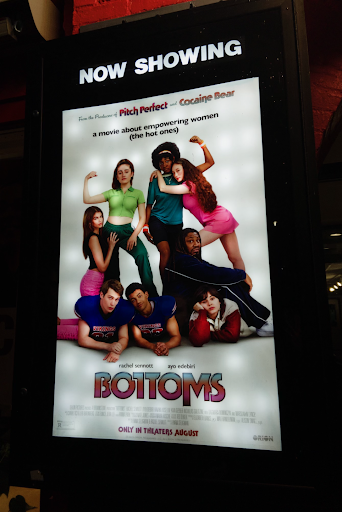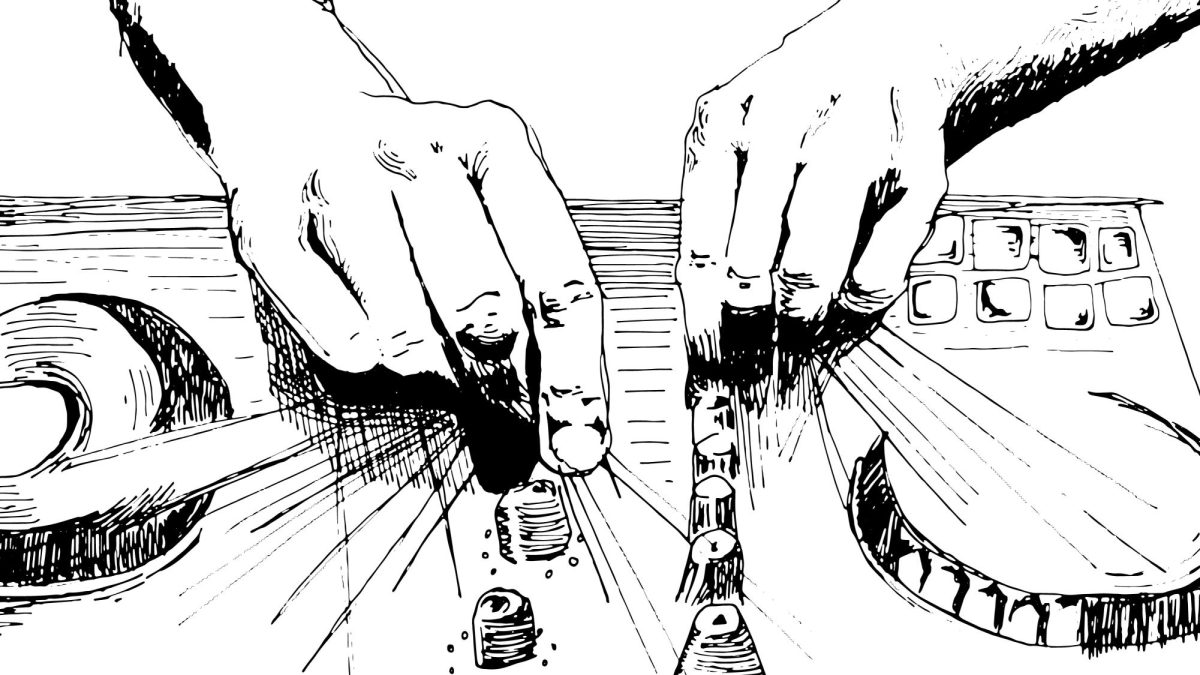
Trigger warning: This article discusses themes of sexual assault and rape.
It’s Superbad, it’s Fight Club… it’s also gay. Emma Seligman’s Bottoms is unapologetic — it’s a thrilling tale about two lesbian virgins trying to get some. The protagonists start their own version of a self-defense fight club meant to empower their female classmates against individuals at their hyper-masculine high school and their rival football team, specifically the two cheerleaders they have crushes on. The film, written by Seligman and Rachel Sennot — who also stars as one of the two protagonists alongside Ayo Edebiri — adds edge, raunch, and queerness to the teenage coming-of-age story.
Students at the College who watched the film at Images Cinema were drawn to its new portrayal and representation of queerness. Many students identified how other movies they previously viewed centering around queer women fell into certain tropes.
“We have not really been given any raunchy, fun, unserious gay movies,” Audrey Kelly ’24 said. “I feel like [queer films] occupy very limited, annoying categories where they’re either period pieces — where it’s yearning and pining and maybe brushing pinkies once — or we get the hyper-voyeuristic Blue is the Warmest Color category, where we get these pornographic scenes. There’s a very limited array of queer movies.”
Bianca Arce ’24 similarly emphasized that movies about queer women typically have ended in tragedy or veered into uncomfortable relationships. “Most critically acclaimed films or the newest [additions] to the genre have always been the most tragic stories,” she said. “Some are extremely slow period dramas, like Portrait of a Lady on Fire or Carol. Or you see depictions of incredibly weird power dynamics… It always seems that one of them dies in the end.”
Students described their excitement about Bottoms’ different, satirical approach to portraying young queer women. “I also really liked how Bottoms showed gay people being bad,” Stella Rothfeld ’26 said. “I feel like media a lot of the time [centers] around minority characters in very racialized, gendered, oversexualized tropes — the films either confirm those narratives, or they make their characters morally superior to tropes to make them appear tasteful to their audiences. And this movie was just not concerned with doing that.”
Kelly agreed, highlighting the ways in which the film did not fall into traditional queer narrative stereotypes. “Coming out isn’t the main conceit… It’s nice to have representation where the conceit isn’t drama, their queerness is not a problem,” they said. “And the [queer protagonists] don’t kill themselves at the end, which is, shockingly, a real victory in this society.”
At the same time, students also highlighted certain aspects of the film that they would have liked to play out differently. “I think the way they handled attraction was a little off in the sense that [the characters] were attracted to someone, and all they wanted was to have sex with them,” Arce said. “It made it a little grotesque, and I don’t think it was condemned enough… Queer relationships tend to be very oversexualized — they tend to be seen as very carnal — so I didn’t like the fact that these queer characters were oversexualizing other characters and making a fight club with the sole purpose of sleeping with those characters.”
Arce also described how she felt that the global audience’s overwhelming positive response to Nicholas Galitzine’s role as Jeff, a popular airhead football player, undercut the film’s efforts to center on queer female comics. For a supporting comedy role, Galitzine received a great deal of attention on social media for his performance as the archetypal “dumb blonde” — something that Arce said has not been traditionally afforded to women playing a similar role. “He was not the point of the film,” she said. “You literally watched a lesbian movie and came out of it wanting to do this het[erosexual] man?”
While students appreciated its deviation from traditional masculine representations of heroism and justified violence, they also expressed the different reactions to the film’s violent finale. “It didn’t feel like they were angry at that team — they were just expressing their rage at everything that had been happening recently,” Rothfeld said. “But at the end I was like, ‘Wow, they just slaughtered that whole team. Slay, I guess.’”
Kelly added that they saw the brutality committed by queer women as a subversion of traditional masculine acts of rage and violence seen in popular shows like Game of Thrones. “We often get gratuitous, unnecessary violence committed by men, so I loved that we got to see this extreme, hilarious violence committed by women or non-men in this movie,” they said. “But I think people’s potential discomfort likely comes, at least in great part, from the fact that we’re not accustomed to seeing women be violent.”
Kelly added that the film not only portrays violence in a comedic light but also touches on issues like sexual assault, domestic violence, and race and allyship. “Rape is acknowledged as a widespread, serious issue for women and people who are assigned female at birth — that’s a valuable assumption that is not questioned or problematized,” they said.
Despite how it reckons with serious themes, Bottoms has ultimately been marketed as a teen comedy. Kelly discussed their positive opinion on how the film satirizes and unapologetically jokes about the aforementioned issues. “The satirical aspect, which is so extreme, enables them to bring up things that may be deemed controversial or taboo — things that, if they were brought up seriously, would have difficulty reaching a more mainstream audience,” they said, noting that Bottoms both toes and crosses the line with its comedy and, therefore, calls for a certain audience.
“The fact that it’s a comedy and not a drama posits certain issues as necessary assumptions,” Kelly continued. “[The viewer] needs to adopt certain assumptions to engage in the comedy in the way the movie wants you to… [and] needs to go into the movie knowing patriarchy is bad, men are stupid, and football is super sexual.”
Rothfeld said that while the film clearly spoke to certain demographics, different viewers would still enjoy it. “There’s definitely a target audience that would receive it well, which is queer or queer-adjecent 15- to 30-something-year-olds,” she said. “Of course, people outside of this target audience would get things from the movie. I think if I showed this film to my parents, they’d be confused — they would have laughed the whole time, but they wouldn’t really know what happened.”
However, Arce thought that the film’s humor felt distinctly Gen Z. “It’s clear that there’s a generation of people that are writing in a different style,” she said. “I think that what is prioritized in the film or what we consider funny is shifting. The humor of our generation is coming through in these types of movies that are created by and catered towards younger people.”
Though the film is made for a contemporary audience, students also touched upon the film’s unique out-of-time aesthetic. They referenced the characters’ 1980s fashion style and how one character listens to music on a Walkman, while simultaneously highlighting how the dialogue speaks to its modern-day audience. Specifically, the lack of smartphones in the film depicted young people outside of the context of social media and the internet in a refreshing way. “I really appreciated how it didn’t include phones, even though I’m aware of how present technology is in our lives,” Aidan McMahon ’26 said. “By drawing from other periods, it makes the [film] a little more adaptable, a little more timeless.”
“I was struck by the atemporality,” Kelly added. “It prompts your suspension of disbelief. It’s slightly adjacent to our world and our present, but it’s also not fully there. I think it enables the satire and makes anything possible..”
Kelly added that the film’s unconventional relationship to time spoke to the disorienting nature of coming of age as a queer person. “I was thinking about the idea of ‘queerness is an act of invention,’ because [as a queer person], you’re inventing a non-normative life, and you’re working in this constant process of fabrication,” they said. “The fact that we’re in a nebulous space is disorienting. We are not fully anchored in a time and place, which enables Bottoms’ non-normative narrative.”
McMahon noted that the homage to previous time periods in the aesthetic contradicted the authentic experience of queer struggles depicted in the film. “When you’re put in a retro or ’80s [and] ’90s mindset, a positive portrayal of queerness is unheard of,” he said. “Now thinking back on it, it does create a disconnect. It made the move feel less real — it was absurd, it was surreal.”
In addition to enjoying its unique out-of-time narrative, students shared a positive sentiment about the new narrative for young queer women that Bottoms has created. “Loads of queer women probably have this experience growing up of not [seeing] lesbians or queer adolescents depicted on screen or in books,” Kelly said. “That’s obviously super isolating… Coming into your sexuality and your identity as a queer woman is a very unique experience. [With Bottoms], it’s nice to not have to disidentify with the straight versions of that [coming-of-age] narrative.”
“I think there [are] enough movies about male virgins who can’t get any,” Arce added. “Why not have a bunch of lesbians do it, too?”







